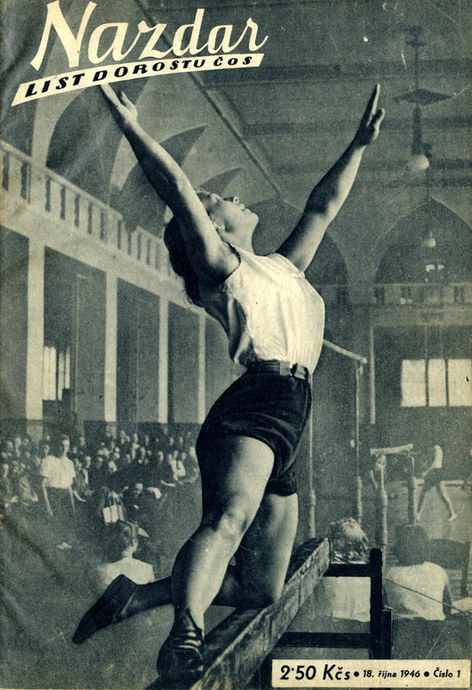Sokol in World War I & II
Sokol’s Role in World War I (1914-1918)
Czech men were obliged to serve in the Austrian Army, which was supported by the armies of Hungary, Germany, Bulgaria, and the Ottoman Empire. They did not approve fighting against the Allies, i.e., Serbia, France, Great Britain, and Russia (and later the United States). Thus, at the onset of the war some Czech soldiers joined the Russian fighting forces, along with their comrades from Russian POW camps, and fought the Austrians and Germans, rather than the Allies. These men, later joined by Slovaks, became known as the legionnaires, when Tomaš Masaryk, the future president of Czechoslovakia began recruiting more men. By 1918 their number had reached about 100,000. The legacy of the Legions was that they fought bravely for the independence of the Czechs and Slovaks from Austro-Hungarian dominance. In 1917, they successfully fought the Bolsheviks in Russia, who no longer supported the Allies. They seized the Trans-Siberian railway and traveled from the Ukraine to Vladivostok, a 6,000-mile journey.
This fighting force was inspired by the Sokol culture of fitness, discipline, hardness, and ethnic pride. Not surprisingly, a remarkable number of legionnaires were Sokol members, and many served in leadership roles in the legions. They fought battles from France and through Russia, and were a very strong voice for the establishment of Czechoslovakia in 1918, That year President Masaryk, a life-long Sokol, said: “Without Sokol there would be no legions, and without legions there would be no Czechoslovakia.”
Establishing an Army to fight with the Allies
against Austria and Germany
against Austria and Germany
- Česká Druža (Czech Brigade) was a fighting force created at the request of the future president of Czechoslovakia, Tomaš Masaryk. Their training was that of the Sokol system.
- Later the Czech Brigade expanded to three Czech-Slovak Legions who fought in in France, Italy and Russia.
- The Legions, with 85,000 men in 1918, became legendary because of the men’s bravery and success in battles.
- Masaryk, who spent time in the US during the war, was able to document that the armies of his comrades were fighting for their independence, while assisting the allies.
- More than 2,000 Czech and Slovak immigrants from the US joined the fighting forces in France during the last year of the war. Many of these men were members of Sokol.
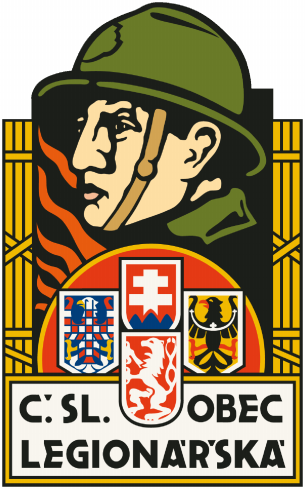
World War I Legendary Czech-Slovak Legionnaires
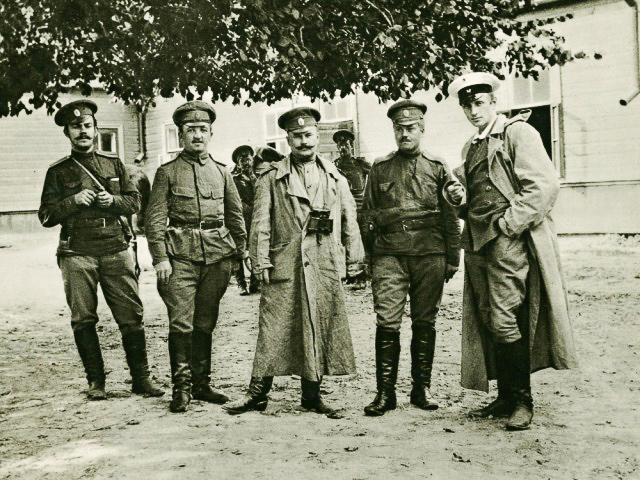
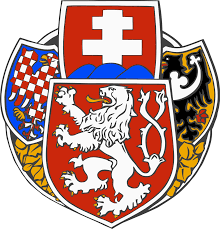
Legionnaire’s insignia Symbols clockwise from bottom: Bohemia, Moravia, Slovakia and Silesia
Legionnaires on a camouflaged
train on the Trans-Siberian Railway
train on the Trans-Siberian Railway
- The was 6,000 miles from Ukraine to Vladivostok, and then by ship to France.
- Their 50,000-man army defeated the Bolsheviks along the journey.
- They were loyal to President Masaryk who had recruited.
- Legionnaires legacies: formation of Czechoslovakia, support of Western countries, and victory for democracy.
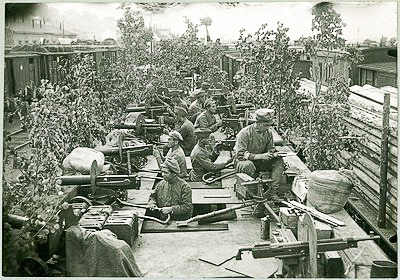
Sokol plays key security role in newly established Czechoslovakia
Czech Organization Sokol
forms “Sokol Guard”
At the end of World War I, and the disintegration of Habsburg authority, Sokols were charged with issues of national and personal security by:
- guarding train stations and trains
- guarding military barracks and fortresses
- confiscating weapons from enemies
- preventing looting and theft
- helping defend Slovakia from Hungarian and
Communist invasion
They served from 1918 – 1922.
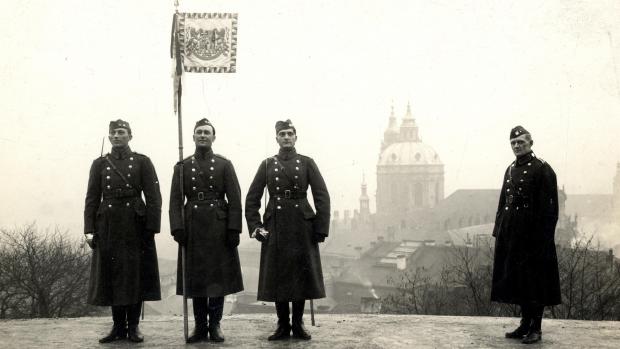
Sokol guards at Prague Castle circa 1919
(photo Military Historical Institute, Prague)
Bohemia and Moravia become a Protectorate of Nazi Germany
German occupation: 1939 - 1945
German occupation: 1939 - 1945
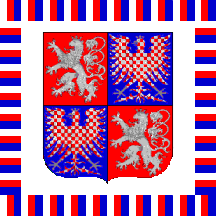
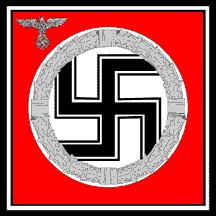
Sokols in the Resistance Movement in World War II
- The Czech Sokol organization played a major role in the resistance during Nazi occupation.
- Sokols built a network of operatives as part of UVOD, the resistance organization.
- Nazis banned Sokols because they understood them to be the most dangerous group.
- Sokols helped in the assassination of Reinhard Heydrich Chief of German Security.
- 11,611 Sokols were imprisoned, 3,296 were executed or died in concentration camps.
- Sokol President Dr. Stanislav Bukovský died in Auschwitz.
- Olympic 1928 parallel bar gold medalist Ladislav Vácha died following his arrest by the Gestopo.
- Jan Gajdoš, two-time World Gymnastics champion died after a death march in 1945.
- Vlasta Děkanova the first women’s World Gymnastics champion worked in the resistance movement throughout the war years.
Remembering the dissolution of the Czech Sokol Organization in
October of 1941 by the Nazis, the
Czechs want to have October 8
added as a national holiday.
October of 1941 by the Nazis, the Czechs want to have October 8
added as a national holiday.
The quotation on the poster refers to former president Masaryk’s words after World War I: Without Sokol there would not have be Legions. Without Legions there would not have been a Czechoslovakia
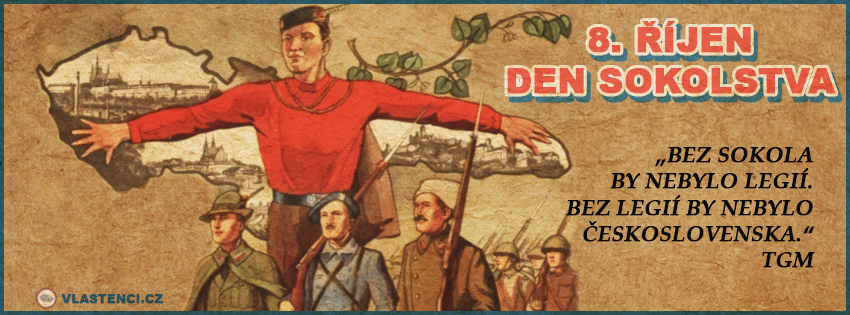
Sokol emerges after World War II (1945-1948)
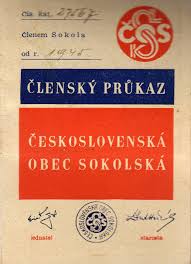
Membership in Sokol
soars ( card for 1945)
- Gymnastic activities resume (magazine for juniors – right photo). Women gymnasts win gold in 1948 Olympics.
- 1948 Slet was a huge success, but Communist
infiltration of Sokols begins and Sokol districts are
dissolved. - 1952 Sokol disbanded.
- 1990 Sokol renewed.
